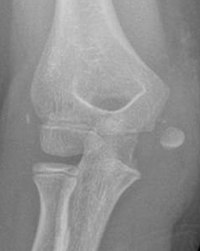
Photo from wikipedia
Objectives: To compare patient-reported outcomes (PROs), range of motion (ROM), and complication rates for proximal humerus fractures managed nonoperatively or with open reduction internal fixation (ORIF). Design: Retrospective cohort. Setting:… Click to show full abstract
Objectives: To compare patient-reported outcomes (PROs), range of motion (ROM), and complication rates for proximal humerus fractures managed nonoperatively or with open reduction internal fixation (ORIF). Design: Retrospective cohort. Setting: Academic level 1 trauma center. Patients/Participants: Four hundred thirty-one patients older than 55 years were identified retrospectively. 122 patients were excluded. 309 patients with proximal humerus fractures met inclusion criteria (234 nonoperative and 75 ORIF). After matching, 192 patients (121 nonoperative and 71 ORIF) were included in the analysis. Intervention: Nonoperative versus ORIF (locked plate) treatment of proximal humerus fracture. Main Outcome Measurements: Early Visual Analog Score (VAS), ROM, PROs, complications, and reoperation rates between groups. Results: At 2 weeks, ORIF showed lower VAS scores, better passive ROM, and patient-reported outcomes measurement information system (PROMIS) scores (P < 0.05) compared with nonoperative treatment. At 6 weeks, open reduction internal fixation (ORIF) had lower VAS scores, better passive ROM, and PROMIS scores (P < 0.05) compared with nonoperative treatment. At 3 months, ORIF showed similar PROMIS scores (P > 0.05) but lower VAS scores and better passive ROM (P < 0.05) compared with nonoperative treatment. At 6 months, ORIF showed similar VAS scores, ROM, and PROMIS scores (P > 0.05) compared with nonoperative treatment. There was no difference in secondary operation rates between groups (P > 0.05). ORIF patients trended toward a higher secondary reoperation rate (15.5% vs. 5.0%) than nonoperative patients (P = 0.053). Conclusions: In an age-, comorbidity-, and fracture morphology-matched analysis of proximal humerus fractures, ORIF led to decreased pain and improved passive ROM early in recovery curve compared with nonoperative treatment that normalized after 6 months between groups. Level of Evidence: Therapeutic Level III. See Instructions for Authors for a complete description of levels of evidence.
Journal Title: Journal of Orthopaedic Trauma
Year Published: 2022
Link to full text (if available)
Share on Social Media: Sign Up to like & get
recommendations!